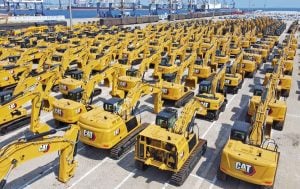Dialogue Earth recently held a series of discussions and workshops on the interlocking issues of China’s trade and investment relationship with Latin America and the Caribbean, green transitions and environmental rights.
The events were a collaboration with the Raoul Wallenberg Institute, ICLAC and FLACSO. They took place from 23-25 April in Santiago, Chile on the sidelines of the third Conference of the Parties to the Escazú Agreement, the region’s first environmental treaty.
Discussions clustered into four key areas: China’s role in the region; its approach to environmental issues; the importance of local conditions and agency in shaping the nature and impacts of China’s investment; and the knowledge gaps that must be bridged to shape the relationship for the better of all.
Understanding Global China
Much of the conversation focused on ways to understand China’s role in investment, trade and green transitions in Latin America and the Caribbean, and more broadly around the world. A number of participants noted how bewildering the Chinese political and overseas investment system can be, alongside the array of terminology and initiatives Chinese actors use.
Several participants mentioned the importance of “disaggregating” China in order to understand the many different actors that make up its system of overseas investment, who often have quite different incentives. Put another way, one participant emphasised, China is not a monolith.
Understanding the various components of the Chinese overseas investment system – from political departments to companies to banks, and the different types of finance they offer – can help local stakeholders engage with China in a more realistic manner. Comprehending the complex web of players is no simple task, however. One participant pointed to resources that map out the different actors and their relationships.
Participants also noted the need to understand the power relationships behind grand initiatives such as the Belt and Road and the Global Development initiatives. These are the “appearance” of Global China, not its “essence”, one participant said. Looking at China through power rather than policy enables us to take a comparative approach to its engagement with the world. This enables a better understanding of the interlinkages between development actors and national governments around the world – to see them as parts of a global political and economic system, rather than discrete worlds of “Western”, “Chinese” or “Japanese” development assistance.
The conversation then moved to a discussion about Chinese concepts of green transitions and environmental rights. It was noted that China’s approach to environmental protection tends to be very technocentric, with environmental engineering playing a major role in the domestic approach to protecting and restoring the natural world. This could present some communication and conceptual gaps with stakeholders in different parts of the world, particularly civil society.
At the same time, however, the technocentric environmental approach was pointed to as an opportunity for Global South countries to redefine their position in the world. This could be done by bringing transition-related industries and technologies to the developing world via economic engagement with Chinese companies expanding into overseas markets, for example in the form of transition mineral processing. The shift in China’s own discussion on environment and climate reinforces this. It has moved from framing the issues as detrimental to development in the 1990s and 2000s to being well aligned with “high quality” development. Meanwhile, the Chinese economy’s increasing reliance on the exports of goods such as solar panels and electric vehicles adds further momentum to the “greening” of trade and investment overseas.
Importance of local action
While it is important to understand the dynamics and logic of China’s engagement with the world, it is also necessary to understand how local conditions can affect the nature of that engagement. Participants noted how it is common to think of China as a monolithic entity that acts unilaterally. As a result, investment projects in countries signed up to the Belt and Road come to be seen as directed and fully controlled by Chinese actors, when in reality host country governments play a major role too, for example in terms of initiating projects, signing MOUs and providing permits.
Special economic zones in Zambia were raised as an example of projects initiated by the host government, rather than by Chinese companies. Another participant noted that pressure exerted on Chinese companies by governments and civil society has a track record of shaping investments. For example, companies may be forced to adhere to local content or processing requirements, as in Indonesia and Zimbabwe. They may also be compelled into consultation with local communities, as in Chiang Rai, Thailand.
In Latin America and the Caribbean, the Escazú Agreement presents an important new avenue for shaping Chinese companies’ operations. Article 9 of the treaty recognises the rights of environmental defenders, giving stronger legal status to local community voices, as well as potentially creating legal obstacles for companies hiring armed security forces around projects. It is also notable that language around human and Indigenous people’s rights, as well as the rights of nature, is enshrined in the Kunming-Montreal biodiversity framework, signed on the back of China’s presidency of UN biodiversity talks in 2022. The latter was cited as an example of how engagement with China can produce positive results, even in areas China is not normally seen as progressive.
How to better engage with China for green and just transitions?
Participants also pointed towards the sizeable gaps in China knowledge and awareness that exist within policymaker communities, civil society and grassroots communities. Closing these gaps, they indicated, could significantly improve the outcomes of Chinese-invested projects, many of which are in sorely needed infrastructures such as power, roads and telecommunications. Some participants argued that a lack of understanding of Chinese players has resulted in poor negotiating by their governments and a lack of strict and enforced conditions on investment. Closing the knowledge gaps could help make for smarter negotiation, they argued. Others noted that knowledge on China remains within a circle of elites in their countries and rarely filters down to the people directly affected by projects.
All in all, it was apparent that discussions such as that held in Santiago enable learning and promote connections between people engaging with different facets of “Global China.” Expanding on this may help close the knowledge gaps identified by participants. This could contribute to building engagements with Chinese companies that produce better results for local communities and the environment.












